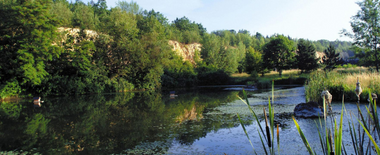Biodiversity & Land Use
Our sites are operated in accordance with relevant international, national and local environmental legislation, with environmental impact assessments prepared generally as a pre-requisite for the permitting of quarrying activities.
In addition to being economically attractive, a potential project must be compatible with the goals of environmental protection. We assign high priority to mining techniques that minimize environmental damage as well as to measures for the subsequent rehabilitation of mining sites. In order to promote biological diversity at our mines, we have adopted group-wide guidelines for species protection. HeidelbergCement is the first company in the construction materials sector to do this. The principles set forth in these guidelines are designed to facilitate dialogue with environmental protection authorities and associations, as well as with the broader public. They are also designed to promote biological diversity and environmental health both during and after mining operations.
Due to our consistent focus towards the Biodiversity, a survey was conducted for our quarries in India and there were 117 bird species recorded at our sites. Please refer the report for the same.


